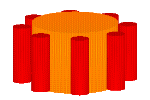 Comparison
Comparison

Since my invention "looks like" Prof. Searl's device, I thought
I should point out the similarities and differences between
Searl's device and my magnetic bubble electrical generator.
First of all, as I mentioned on the
previous page,
my invention
does not pertain to a specific magnet configuration. And since Prof.
Searl does not have a patent on the configuration
shown, we are free to use this configuration (if we can find a
way to make it work!) Prof. Searl has done a wonderful job at
describing the configuration of his devices, and he has attempted
to describe what makes them work, but never in complete detail
so that others can reproduce his results. We are therefore free
to devise our own way to make this magnet configuration work.
So, the comparison between Prof. Searl's device and my
magnetic bubble device will be between what Searl
claims causes his device to work and what I claim causes my
magnetic bubble device to work.
Note that Prof. Searl's center magnet is to be a ring and not
a solid cylinder as illustrated above. His more recent arrangement
has this center ring consisting of cylindrical layers of different
material. (For example, Neodymium, Nylon, a magnetic layer of unknown
composition ("unknown" to me anyway), and copper.)
So the illustration here is not accurate to Prof. Searl's
devices.
Differences
- Prof. Searl claims
that BOTH the disk shaped magnets (red)
AND the center magnet (orange) need to be
specially magnetized (according to his "Law of Squares".)
This is NOT the case for my magnetic bubble
devices. The center "magnet" need not even be a magnet.
In my devices, it is to be a magnetic field gradient
source. This could even be an electro-magnet.
- Searl claims that you must use his "Law of Squares"
to make his device work. This is not the case for my
magnetic bubble devices. In Searl's device, the "Law of Squares"
governs all aspects of the device including what frequency
to use during the magnetization process as well as the amount of
each of the various materials used to construct Searl's device.
My magnetic bubble devices are to be constructed based on
what is known about the generation/creation of magnetic bubbles
and the materials which support magnetic bubbles. Of course,
more research needs to be done in this area of science to learn
what the best magnetization process is and what the best material
would be. We look to the experimental sciences to guide us, not to
Prof. Searl's "Law of Squares."
- Searl claims that after the magnetization of both the
center ring and the disk shaped "segments", (at
different frequencies) there is a
detectable magnetic pattern in the magnets.
(From what I gather, if you use iron filings to see the
pattern, a bicycle-spoke-like pattern should be visible.
That is, an alternating "light-dark" pattern should appear around
the magnets.
However, I may have misunderstood what specific pattern should
emerge in Searl's magnets.) For my magnetic bubble magnets, I do
not expect any special "pattern" to appear, using iron filings,
because the magnetic bubbles are too small and
should be evenly distributed throughout the material. However,
since the magnetic disks will have a "north" face and a "south"
face (as do normal disk magnets) and since iron filings
sprinkled over one face of a normal disk shaped
magnet can look like radial spokes (from the edge of the
magnet outward) it is not clear to me what the difference
is between Searl's magnet "pattern" and a normal magnetic pattern is
suppose to be. Since, in my device, the magnetic bubbles are too
small to be
detected by the iron filing method, any spoke-like pattern
may simply be a normal pattern for magnets. In short, no
special magnetic pattern is expected in the magnetic bubble
magnets when iron filings are used. (Magnetic bubbles are detectable
using other methods.)
- For Searl's devices, it is the interaction and difference
between the pattern
printed on the center magnet and the pattern on the disk shaped
segment magnets which causes the segments to roll around the
center magnet. Apparently, the interaction of the two patterns
always causes an imbalance in the segments which causes them to
move around the center magnet. In my magnetic bubble device,
there is no special magnetic pattern on the center magnet (which
might not even be a magnet as mentioned above). The cause for the
motion in my magnetic bubble device is the force which
develops on a magnet bubble when it moves through the
magnetic material in a magnetic field gradient. This is
well known in the literature on magnetic bubbles. (However,
no one in the literature seems to have mentioned the possibility
of using this force to move the material in which the magnetic
bubbles exist, which is why I have apply for a patent.)
- For Searl's device, the magnetization frequency for the disk
segment magnets is determined by the "level of the square"
used to create the segments. Likewise for Searl's center magnetic
ring; the frequency of magnetization is determined by the "level of
the square" used to create the ring. These two frequencies (between
the segments and the center ring magnet) are not the same. For my magnetic
bubble devices the pulse shape of magnetization of the disk segment magnets
is determined by consulting the scientific literature on the creation
of magnetic bubbles.
- Searl claims that there is a lot more going on in his devices than
what I have mentioned here about his devices, both in its construction and cause of
operation. For example, when the segments are constructed by layering the
material, there is an electrical charge developed between the center of the segment
and the outer edge of the segment.
There is no comparison I can make between this
(and other aspects of Searl's device) and my device because
my construction details are different than Searl's.
Because of these differences between what Prof. Searl claims
causes his device to work and what I claim causes my magnetic
bubble device to work, I concluded that my device is different
than Prof. Searl's device. As mentioned above, the configuration
of the magnets appears to be similar (except in the case of
the center magnet being an electromagnetic in one of my
configurations) but the explanation for the motion of the
magnets is very different.
Similarities
I am sure you can see several similarities between my magnetic bubble
device and Searl's device, but I'll list some of them anyway. Note that
these are "similarities", not exact matches as I point out above.
- Configuration of the magnets: I am using Prof. Searl's
general configuration of stacks of disk shaped magnets self-rotating
around a center magnet.
- Magnetization process: Searl uses an AC magnetic field on top
of a DC magnetic field. This is similar to the magnetic process I will use
to generate magnetic bubbles. I will use magnetic pulses on top of a DC
magnetic field.
- Energy Extraction: Searl uses "C" shaped coil cores positioned so
that the rotating stack of magnets passes through the "C". If I ever get
this far along in realizing my device, I will be using "C" coil cores as well.
I look at these similarities in the same way that a gasoline
engine is similar to a diesel engine. They are similar but not
exactly the same.
After learning about my patent application for my magnetic bubble
motor, Prof. Searl wrote on his web page that his "legal department"
was going to look into my patent application and that it was
doubtful that I would be granted a patent, presumably because
he felt that I had discovered nothing new or because I
was attempting to patent his device. I have ask both
Prof. Searl and his USA associate (John Thomas) to provide
my lawyers or myself
with copies of any documents which might indicate
that Prof. Searl has
a prior claim to using magnetic bubbles to move the material
in which they exist. This request was made over 8 months ago.
So far no documents have been provided.
I have also asked them to provide me with documentation
which would resolve the differences I have listed above
between Prof. Searl's devices and my magnet bubble device
in enough detail so it becomes obvious that my device works
in the same way as Prof. Searl's device. No documents
have been provided.
Until such time as these documents are provided, I will
continue to work under the assumption that my device is different
than that of Prof. Searl's. However, I well continue to acknowledge
my use of Prof. Searl's general configuration of stacks of disks
moving around a center source, as I have done on several other
web pages.
One day, I hope that Prof. Searl will make a FULL
disclosure of his inventions.
After 15+ books, he has yet to do so. We would then be able to
make a more accurate comparison between his method and
explanation and mine.
The information provided here is subject to patent protection. USA patent pending,
June, 1998
Usage Note: My work is copyrighted. You may use my work but
you may not include my work, or parts of it, in any
for-profit project
without my consent.
 Comparison
Comparison
